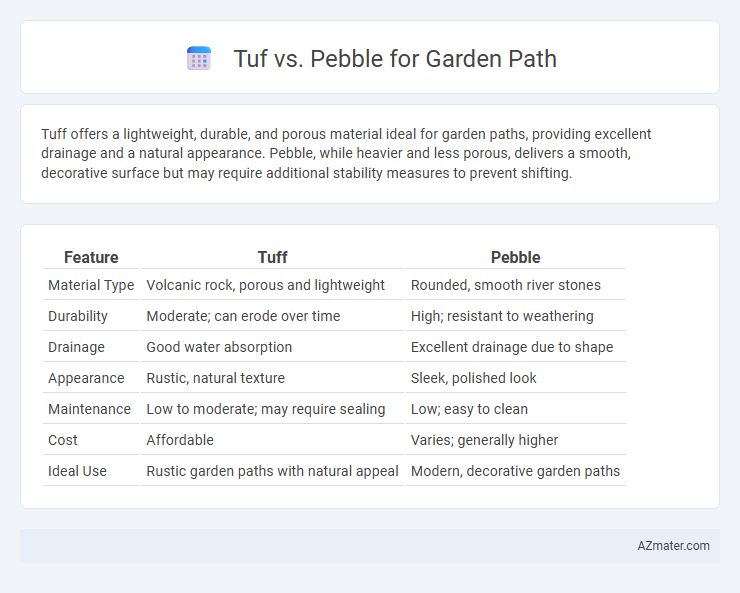Tuff offers a lightweight, durable, and porous material ideal for garden paths, providing excellent drainage and a natural appearance. Pebble, while heavier and less porous, delivers a smooth, decorative surface but may require additional stability measures to prevent shifting.
Table of Comparison
| Feature | Tuff | Pebble |
|---|---|---|
| Material Type | Volcanic rock, porous and lightweight | Rounded, smooth river stones |
| Durability | Moderate; can erode over time | High; resistant to weathering |
| Drainage | Good water absorption | Excellent drainage due to shape |
| Appearance | Rustic, natural texture | Sleek, polished look |
| Maintenance | Low to moderate; may require sealing | Low; easy to clean |
| Cost | Affordable | Varies; generally higher |
| Ideal Use | Rustic garden paths with natural appeal | Modern, decorative garden paths |
Introduction to Garden Path Materials: Tuff and Pebble
Tuff and pebble are popular materials for garden paths, each offering distinct textures and durability. Tuff, a volcanic rock, provides a porous yet sturdy surface ideal for natural-looking pathways with excellent drainage. Pebbles deliver a smooth, rounded finish, enhancing aesthetic appeal and allowing flexible design options in garden landscaping.
What is Tuff? Characteristics and Uses
Tuff is a type of volcanic rock formed from the consolidation of volcanic ash, characterized by its lightweight, porous structure, and relatively soft texture compared to other stones. Its natural durability and ease of cutting make tuff ideal for garden paths, providing good drainage and a rustic aesthetic. Used widely in landscaping, tuff offers stability for walkways while blending seamlessly with natural garden environments.
What are Pebbles? Natural Beauty and Features
Pebbles are small, naturally rounded stones often used in garden paths for their aesthetic appeal and functional benefits. Their smooth texture and variety of colors enhance garden designs by providing a natural, organic look while improving drainage and preventing soil erosion. Unlike manufactured materials, pebbles retain a timeless beauty that complements diverse landscaping styles and withstands weather changes seamlessly.
Visual Appeal: Tuff vs Pebble in Landscape Design
Tuff offers a rugged, textured look with naturally occurring warm earth tones that enhance garden paths with a rustic charm. Pebbles provide a smooth, polished surface available in various colors and sizes, creating a refined and versatile aesthetic. Choosing between Tuff and Pebble depends on whether the design prioritizes natural, coarse textures or sleek, customizable finishes for visual appeal.
Durability and Maintenance Comparison
Tuff offers superior durability for garden paths due to its dense composition and resistance to cracking under heavy foot traffic and weather conditions, making it ideal for long-term use. Pebble surfaces require more frequent maintenance as they can shift, become loose, and accumulate debris, leading to uneven walking areas and potential tripping hazards. Choosing Tuff reduces upkeep efforts while ensuring a stable, wear-resistant path that maintains its aesthetic appeal over time.
Cost Analysis: Tuff vs Pebble Installation
Tuff installation for garden paths generally costs more upfront due to material strength and durability, averaging $8 to $12 per square foot, while pebble installation ranges from $4 to $7 per square foot, making it a budget-friendly option. Labor expenses for Tuff are higher because of the need for specialized equipment to handle heavy material, whereas pebble paths require simpler groundwork and spreading techniques. Considering long-term maintenance, Tuff offers lower costs due to its resilience against wear, whereas pebble paths may incur periodic replacement or repositioning costs.
Slip Resistance and Safety Considerations
Tuff offers superior slip resistance for garden paths due to its rough texture and porous surface, minimizing the risk of slips in wet conditions. Pebble surfaces, while aesthetically appealing, can become slippery when wet, posing safety concerns, especially in high-traffic or shaded areas. Choosing Tuff enhances overall garden path safety by providing better traction and reducing accidents.
Eco-Friendliness and Sustainability Factors
Tuff is a natural volcanic rock that offers superior permeability and durability, making it an eco-friendly option for garden paths by minimizing water runoff and soil erosion. Pebble, often composed of river stones or crushed limestone, provides good drainage but may require more frequent replacement due to wear, impacting sustainability. Choosing Tuff supports environmental conservation through its longevity and minimal maintenance, aligning better with sustainable landscaping practices.
DIY Installation: Ease of Laying Tuff vs Pebble Paths
Tuff offers a lightweight and uniform texture, making DIY installation straightforward with fewer leveling adjustments needed compared to pebbles, which require more effort to achieve a stable, even surface due to their irregular shapes. Pebble garden paths demand additional labor for weed suppression and edge containment, increasing installation time and complexity. Tuff's consistent size and compact nature simplify laying and finishing, ideal for quick, durable garden paths without professional assistance.
Best Applications: Choosing Tuff or Pebble for Your Garden Path
Tuff, a durable volcanic rock, offers excellent stability and weight, making it ideal for high-traffic garden paths that require long-lasting surfaces. Pebbles provide a smoother, more decorative finish ideal for low-traffic areas, promoting drainage and lending a natural aesthetic to garden landscapes. Selecting Tuff ensures structural integrity for functional walkways, while pebbles enhance visual appeal and environmental integration in garden design.

Infographic: Tuff vs Pebble for Garden Path
 azmater.com
azmater.com